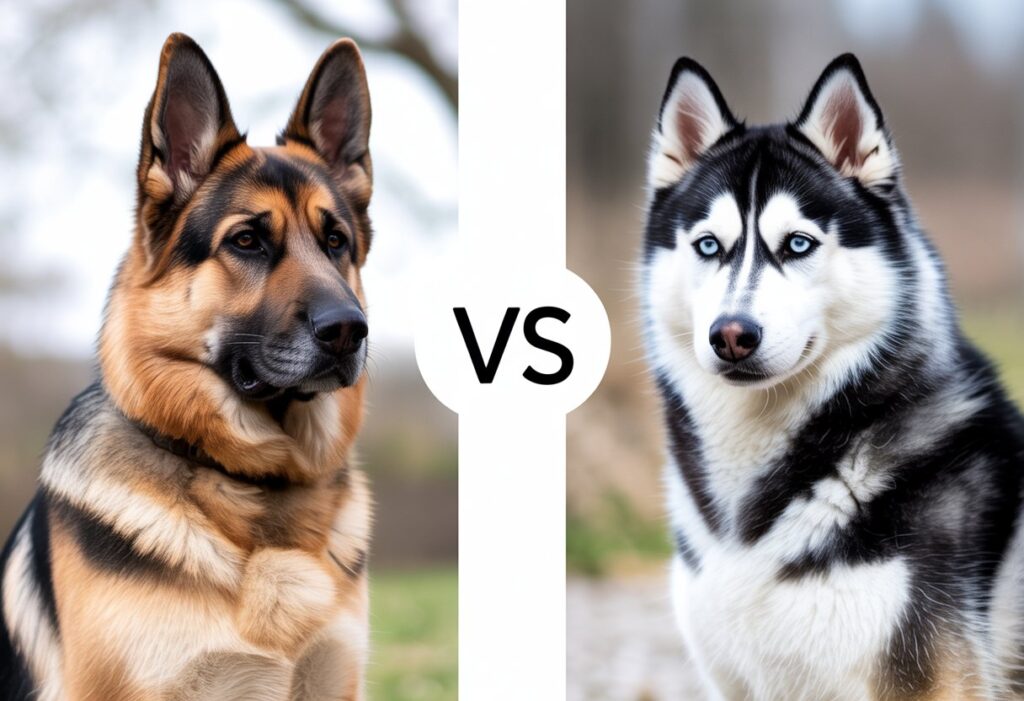If you’re after a loving companion but can’t choose between the Cavalier King Charles Spaniel and the Papillon, you’re definitely not alone. Both breeds are small and friendly, but each brings its own unique quirks to the table.
The Cavalier King Charles Spaniel is usually more laid back and snuggly, while the Papillon comes packed with energy and smarts.
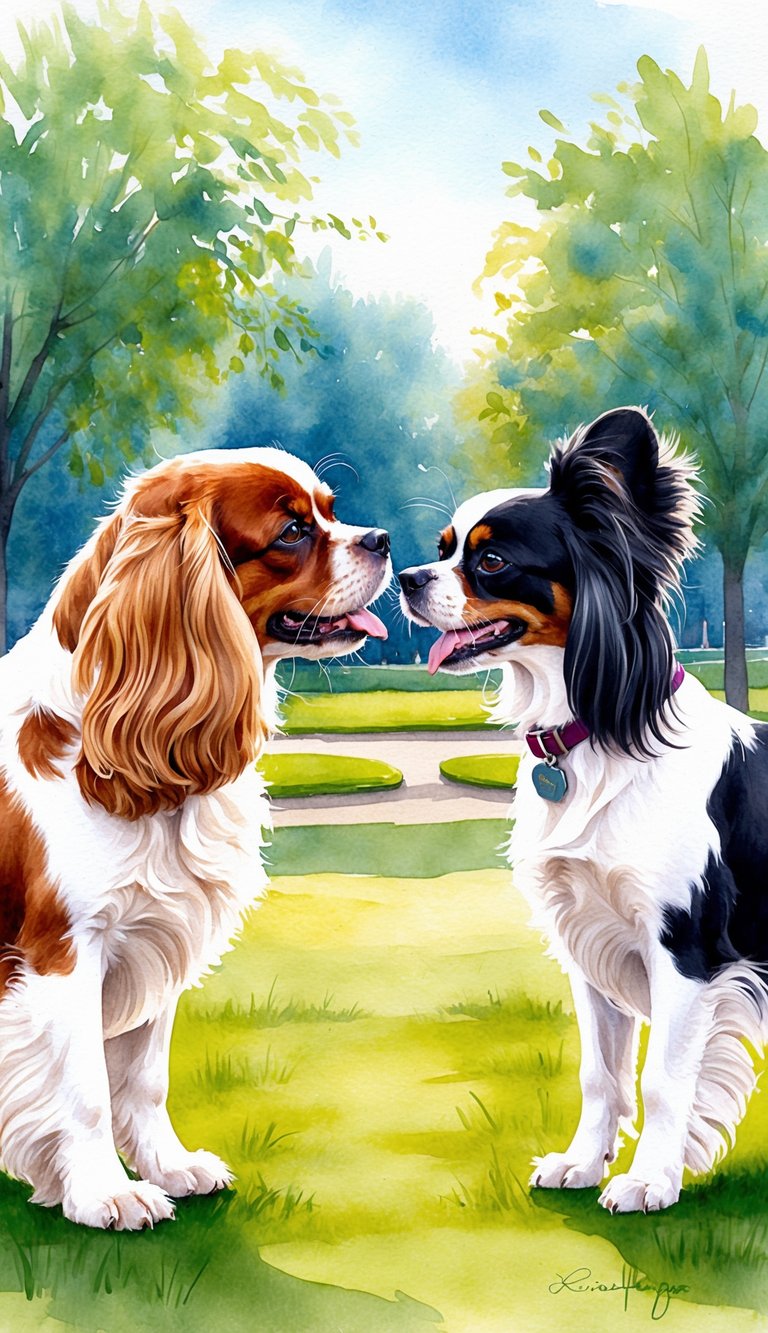
Their appearance, grooming needs, and the way they mesh with families or other pets all differ. Knowing these details can make it way easier to figure out which breed actually fits your life.
Maybe you’re dreaming of a mellow lapdog, or maybe you want a lively little partner for adventures. Lining up these two breeds side by side should help clear things up.
Breed Origins and History
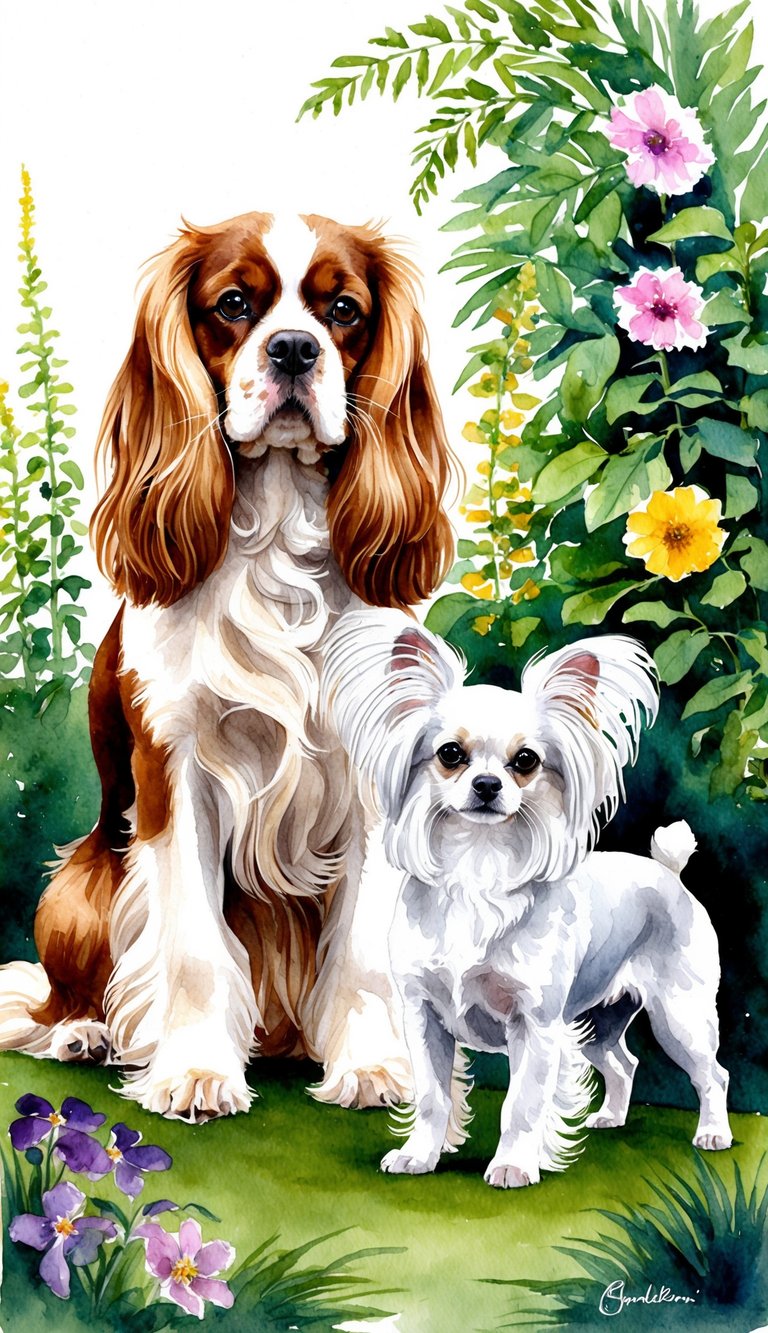
Both the Cavalier King Charles Spaniel and the Papillon have been companions to people for ages. Each breed’s backstory is a little different, though.
Cavalier King Charles Spaniel Background
The Cavalier King Charles Spaniel traces its roots to 16th-century England. King Charles II adored these little spaniels, so much so that they’re named after him.
You’ll spot these dogs in old paintings, usually hanging out with royalty. Early Cavaliers weren’t bred for hunting, just for keeping people company.
They’re closely related to the English Toy Spaniel (also called the King Charles Spaniel). In the 1920s, breeders in Britain tried to bring back the look of the original lapdogs from those old portraits.
Today’s Cavaliers are friendly, loving, and happiest when they’re with their people.
Papillon Breed History
The Papillon hails from continental Europe, mainly France and Belgium. The name means “butterfly” in French, a nod to those big, fringed ears.
This breed’s history goes back several centuries. You’ll find Papillons in Renaissance-era paintings, often sitting with French nobles or queens like Marie Antoinette.
There are two ear types: the upright-eared Papillon and the drop-eared Phalène. Both are part of the same breed, sharing similar personalities.
Recognition by Kennel Clubs
Major kennel clubs recognize both the Cavalier King Charles Spaniel and the Papillon.
- The American Kennel Club (AKC) added the Papillon in 1915, but the Cavalier didn’t join until 1995.
- The United Kennel Club (UKC) and the Kennel Club (UK) also list both breeds.
They’re in the Toy Group. You’ll see them in conformation shows and dog sports.
Breed standards help guide breeders and owners on traits like size, temperament, and appearance.
Physical Characteristics
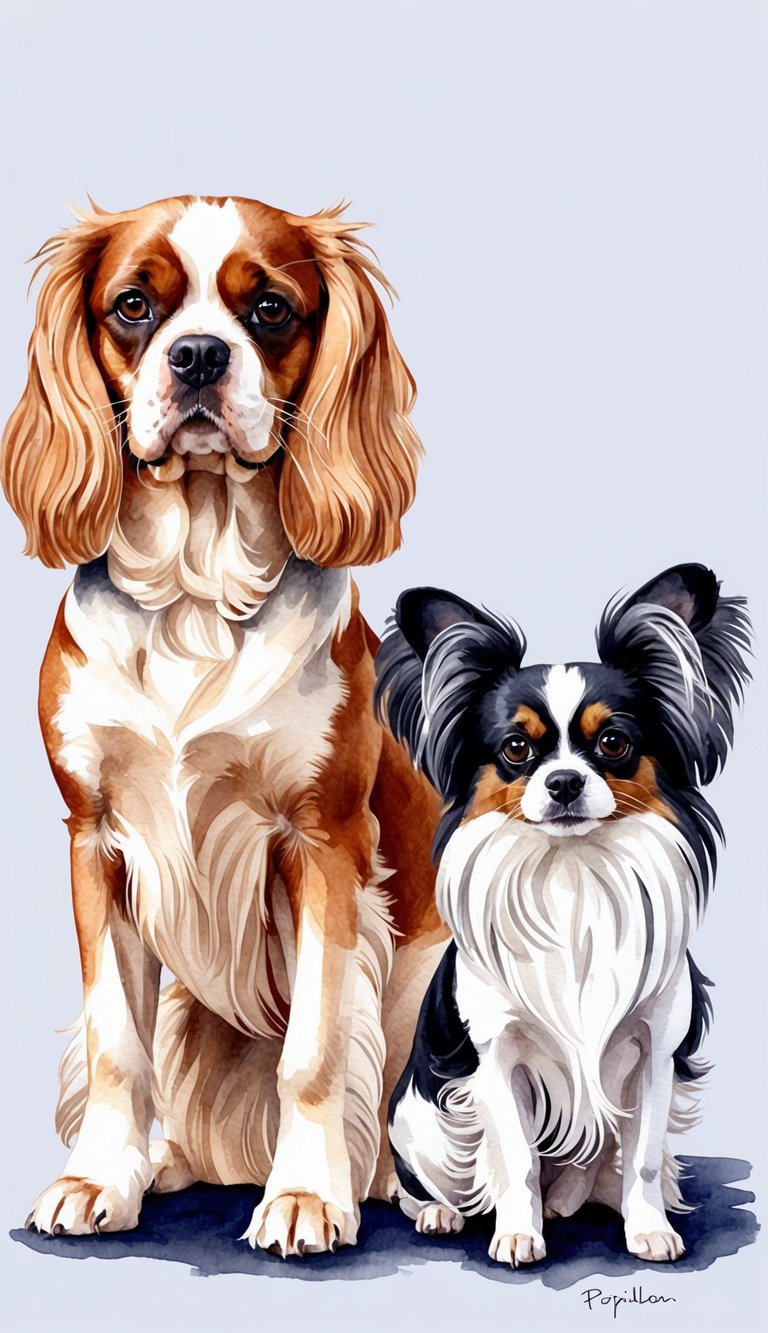
Both the Cavalier King Charles Spaniel and the Papillon fit into the toy breed category, but you’ll notice plenty of differences when you look closer. Size, coat, and those little details can matter a lot when you’re choosing a dog.
Size and Weight
The Cavalier King Charles Spaniel is a bit bigger than the Papillon. Adults usually stand about 30–33 cm (12–13 inches) tall and weigh 5.9–8.2 kg (13–18 lbs).
The Papillon is smaller and lighter—think 20–28 cm (8–11 inches) tall and 1.8–4.5 kg (4–10 lbs) in weight.
You can carry either one, but Cavaliers have more heft. Papillons are great if you want a tiny dog that’s easy to pick up and tote around.
Coat Types and Colors
The Cavalier King Charles Spaniel sports a silky, medium-length coat. It’s mostly straight, sometimes with a little wave, but never curly.
Common colors: Blenheim (chestnut and white), Tricolor (black, white, and tan), Ruby (solid red), and Black & Tan.
The Papillon has a long, fine coat that looks lighter and flows more. Their name really fits, since those fluffy, fringed ears look a lot like butterfly wings.
Papillons usually have a white base with splashes of sable, black, brown, or red.
Both breeds have single coats, so they don’t shed as much as double-coated dogs. Still, you’ll need to brush them often to keep tangles away.
Distinct Breed Traits
Cavaliers have those big, soulful eyes and a sweet, gentle face. Their long, feathered ears hang down close to the head, and their build is compact and graceful with a plumed tail.
Papillons stand out with their big, upright “butterfly” ears, fringed with long hair. Some have drop ears (Phalène), but most have the classic upright style.
Papillons have a dainty, alert look, while Cavaliers seem softer and more relaxed. These traits really help people fall in love with one breed over the other.
Temperament and Personality
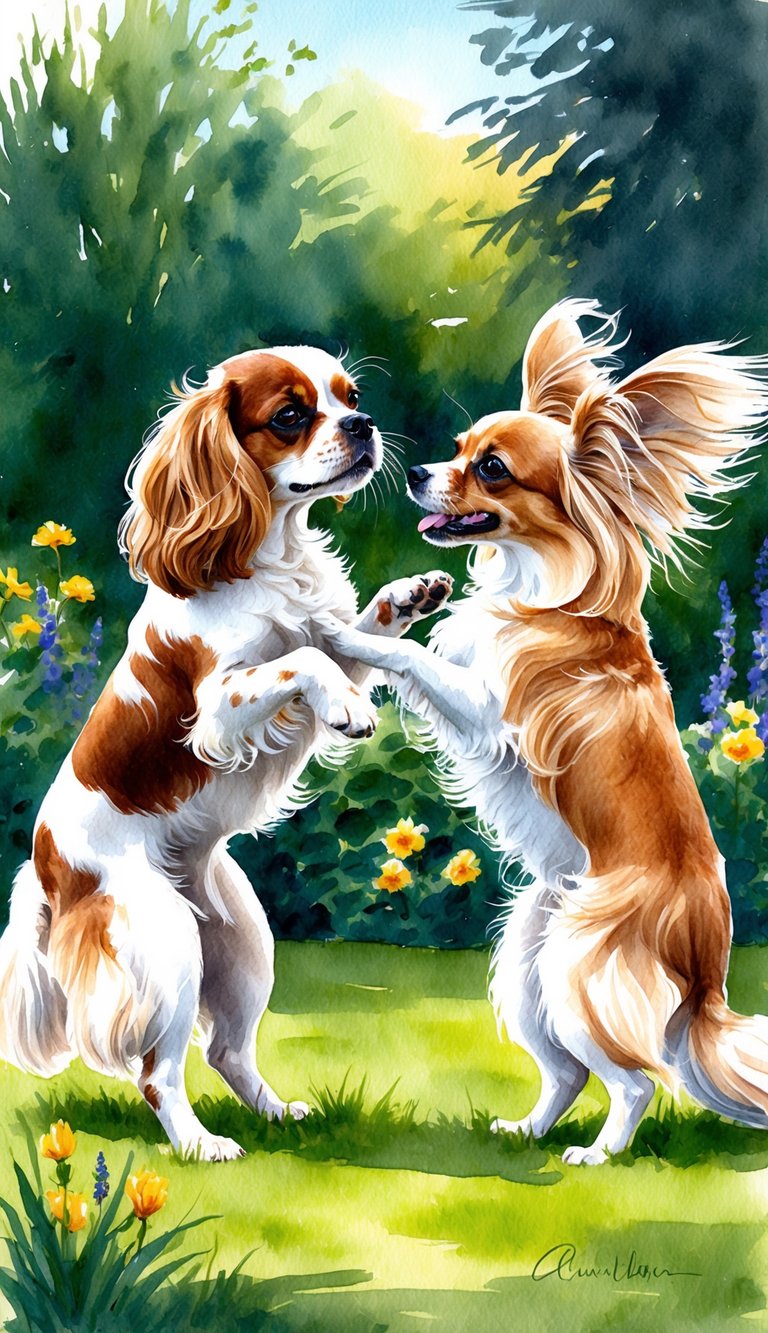
Cavalier King Charles Spaniels and Papillons both make loving, clever pets, but their personalities aren’t quite the same. Their loyalty, trainability, and how they fit with families can be pretty different.
Affectionate Nature
Cavaliers are super affectionate and thrive on being close to people. They tend to bond with everyone in the house and like to stick close, whether that’s curled up on your lap or following you around.
Papillons love their people too, but they’re a bit more independent. They often pick a favorite person or two, and while they’ll snuggle, they don’t always need to be glued to your side.
Both breeds soak up attention. If you want a dog that’s excited to see you and loves to snuggle, either will do, but Cavaliers are usually more eager to please. Papillons, on the other hand, sometimes show affection when they feel like it.
Intelligence and Trainability
Papillons are famously smart. They learn new commands fast and shine in obedience or agility competitions.
Many Papillons love learning tricks and tackling puzzles. Cavaliers are also clever, but usually a bit less intense about it.
They respond well to positive reinforcement but might not pick things up as quickly as a Papillon. Both breeds need gentle training—harsh corrections can make them anxious or withdrawn.
Papillons, especially, can get bored if you don’t give them enough to think about.
Quick Comparison Table
| Trait | Cavalier King Charles Spaniel | Papillon |
|---|---|---|
| Willingness | Very eager to please | High but independent |
| Learning Speed | Fast | Very fast |
| Best With | Treats, praise | Variety of rewards |
Suitability as a Family Pet
Cavalier King Charles Spaniels are a favorite for families. They’re gentle, calm, and usually get along with kids and other pets.
Papillons can make great family dogs too, especially if you start socializing them early. They’re livelier and more energetic, which older kids often love.
Because Papillons are tiny and a bit delicate, you’ll want to supervise play with very young children.
Both breeds adapt well to apartments or houses. Cavaliers tend to handle busy homes better, thanks to their tolerant nature, while Papillons often prefer a quieter vibe.
Companion Dog Qualities
Both breeds are classic companion dogs—they really just want to be with you. Cavaliers are loyal and people-focused, and they don’t like being left alone for too long.
If they feel ignored, they can get a little sad. Papillons also love company, but they’re a bit more independent and less likely to develop separation anxiety if they have enough to do.
If you’re after a cuddly dog who loves quiet moments, go with a Cavalier. If you want a playful, energetic buddy for activities and games, a Papillon could be a better fit.
Either way, both breeds are great at bringing happiness and affection into your life.
Exercise and Activity Needs
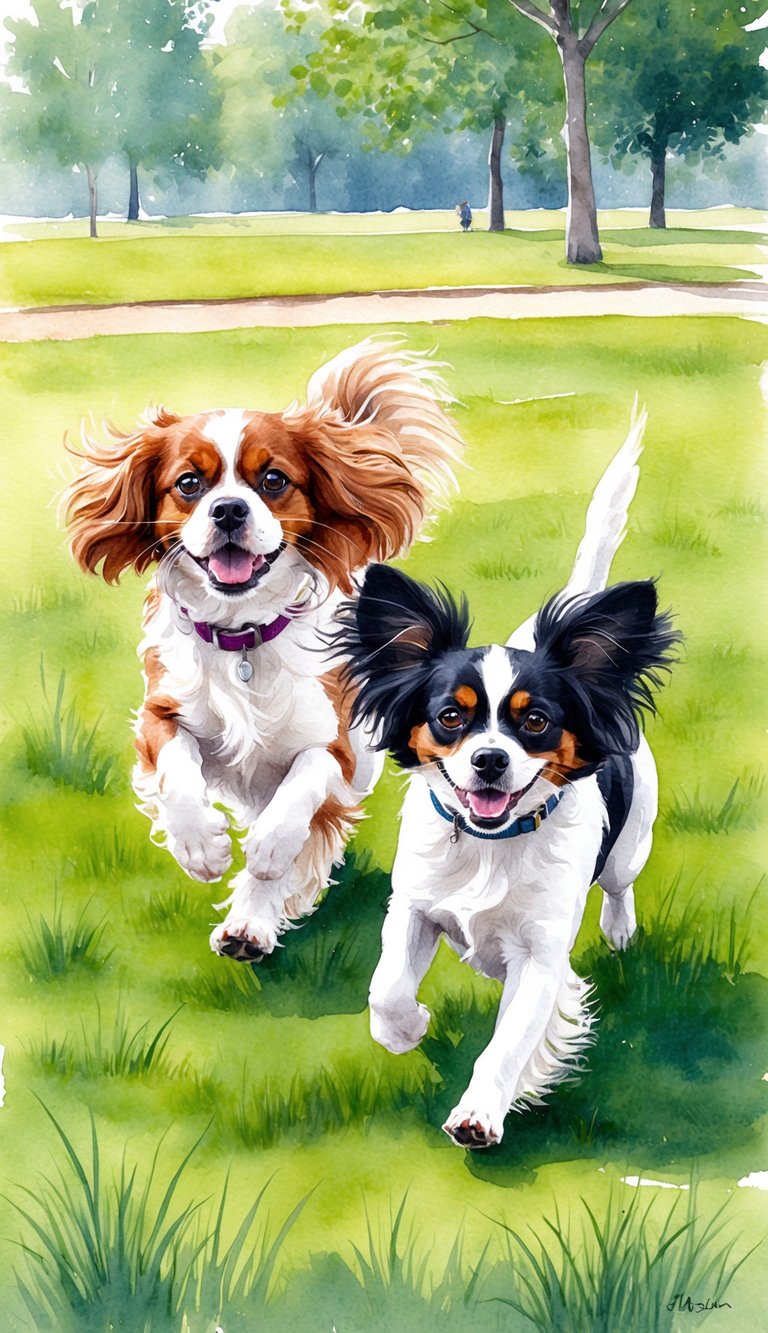
Cavaliers and Papillons are both toy breeds, but their energy levels aren’t quite the same. Meeting their exercise and mental needs keeps them healthy and out of trouble.
Daily Exercise Requirements
Cavaliers are happy with moderate exercise. A 20–30 minute walk each day, plus some playtime, usually does the trick.
They enjoy a stroll around the neighborhood or a relaxed park visit. Papillons, though, have a bit more pep.
They need about 30–45 minutes of activity daily. You can split this into two short walks and some play.
Papillons love running in safe, fenced spaces. Neither breed needs intense workouts, but skipping daily activity can lead to weight gain or boredom.
| Breed | Daily Exercise Time | Type of Activity |
|---|---|---|
| Cavalier King Charles Spaniel | 20–30 minutes | Walking, gentle play |
| Papillon | 30–45 minutes | Walking, active play |
Interactive Play and Stimulation
Physical activity is only half the story. Both breeds need mental stimulation to stay happy.
Puzzle toys and simple games work wonders. Cavaliers are into gentle games like fetch or short training sessions with treats.
They just want to spend time with you, and a few bursts of play are usually enough. Papillons, on the other hand, love challenges.
Hide-and-seek, learning tricks, or even agility courses keep them interested. Switching up toys and games helps prevent boredom.
Tips for play:
- Offer soft toys for chewing
- Use puzzle feeders at mealtime
- Change games often to keep things fresh
Health and Genetic Considerations
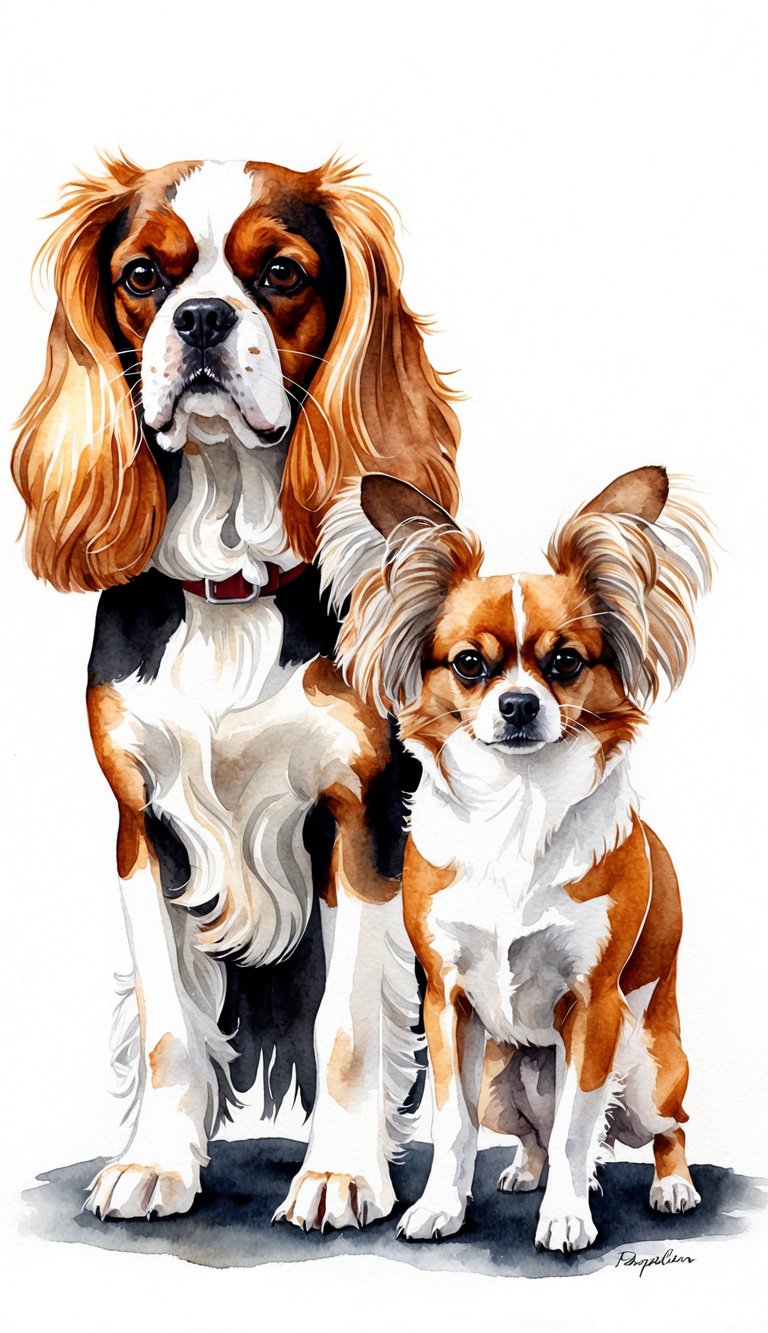
Cavalier King Charles Spaniels and Papillons both come with their own set of health risks and genetic quirks. Knowing what to watch for can help you spot problems early and make better choices for their care.
Common Health Issues
Cavalier King Charles Spaniels face several inherited health problems. The most common are mitral valve disease, obesity, eye disorders, and hip dysplasia.
Papillons tend to be healthier overall, but they can still be at risk for patellar luxation, dental problems, and progressive retinal atrophy.
Both breeds can experience deafness and some autoimmune disorders. Regular checkups, a good diet, and exercise help keep many of these problems in check.
| Health Issue | Cavalier King Charles Spaniel | Papillon |
|---|---|---|
| Mitral Valve Disease | Very common | Rare |
| Eye Problems | Common (cataracts, dry eye) | Rare (mainly PRA) |
| Patellar Luxation | Occasional | Common |
| Deafness | Possible (congenital or acquired) | Possible |
Mitral Valve Disease and Heart Concerns
Mitral valve disease (MVD) is unfortunately widespread in Cavaliers. Over half of these dogs develop this heart condition by age five.
MVD causes the mitral valve to break down, leading to heart murmurs, heart failure, and a reduced quality of life. Papillons almost never get MVD.
If your Cavalier coughs, slows down, or seems short of breath, get them checked as soon as possible. There isn’t a cure, but regular heart exams can help you catch issues early and manage symptoms.
Annual vet heart checks are a must for Cavaliers. Early care can make a real difference.
Neurological Conditions
Cavalier King Charles Spaniels are also known for neurological problems, especially chiari-like malformation and syringomyelia (SM). These happen when the brain and skull don’t quite match up in size, which can cause pain or even paralysis.
Watch for scratching at the neck, sudden yelps, or trouble walking and jumping. MRIs are usually needed for diagnosis.
Papillons rarely face these exact problems, but they can develop other neurological issues like epilepsy. Treatments for chiari-like malformation and SM focus on managing pain, and sometimes surgery helps.
Genetic testing and careful breeding can lower the odds of these diseases.
Genetics and DNA Testing
Both breeds can pass down genetic health issues. Cavalier breeders often check for alleles connected to MVD, syringomyelia, and curly coat (a rare but serious disorder).
Papillon breeders test for genes tied to progressive retinal atrophy, patellar luxation, and congenital deafness. Modern DNA tests let you spot many conditions before symptoms show up.
Responsible breeders use these tests to reduce health risks in puppies. Ask for proof of health screenings and DNA test results before you buy.
That way, you give yourself the best shot at a healthy, happy companion.
Grooming and Maintenance
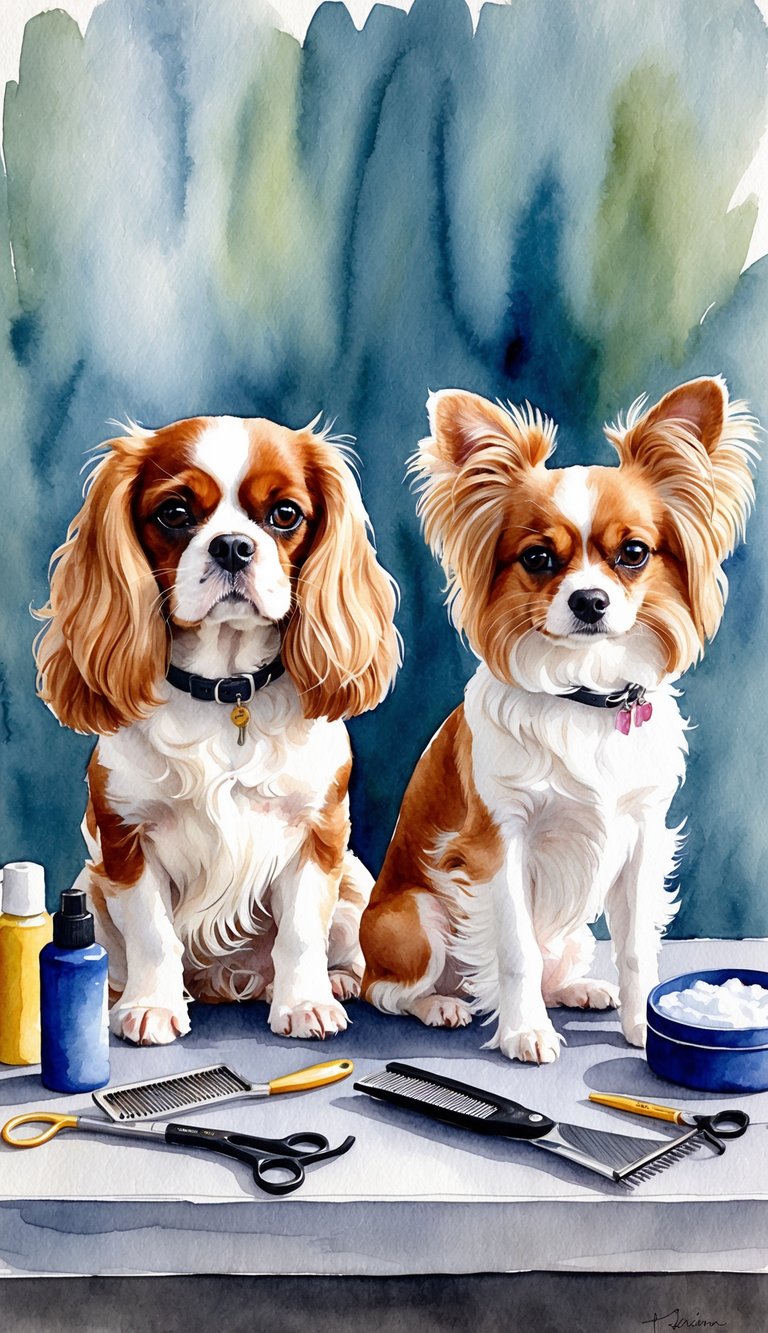
Cavalier King Charles Spaniels and Papillons each come with their own grooming needs. Their coats need different routines, and they shed at different rates, which can definitely impact allergies and how much you clean up.
Coat Care Routines
Cavalier King Charles Spaniels have long, silky fur that needs brushing three or four times a week. This keeps tangles and mats under control, especially behind the ears and around the legs.
A soft-bristle brush or a metal comb works best. Papillons have fine, flowing coats without an undercoat.
Brushing them two or three times a week usually does the trick. Pay extra attention to the fringes on their ears, where knots like to form.
Key differences:
| Breed | Brushing Frequency | Tools Needed |
|---|---|---|
| Cavalier King Charles Spaniel | 3-4 times/week | Soft brush, metal comb |
| Papillon | 2-3 times/week | Soft brush, detangler |
Both breeds do better with monthly baths. Trim nails every few weeks and check their ears for dirt or infection while you’re at it.
Shedding and Allergies
Cavalier King Charles Spaniels shed moderately all year. Their fur tends to show up on furniture and clothes pretty quickly.
You’ll probably need to vacuum more if you have a Cavalier. Papillons shed less, so they’re a bit easier to manage, but they’re not hypoallergenic.
Both breeds can still trigger dog allergies because of dander. If you worry about allergies, weekly brushing and regular baths can help keep loose hair and dander down.
Lint rollers and keeping pet beds clean also help keep shedding under control.
Training Approaches and Socialization

Cavalier King Charles Spaniels and Papillons both respond well to positive training. Early socialization goes a long way in helping them become friendly and confident.
Basic Obedience Training
Both breeds are smart and eager to please, so most people find them easy to train. Papillons often pick up commands fast and stay focused during sessions.
Cavaliers are gentle and do best with calm, encouraging guidance. Use short training sessions, treats, and praise.
Skip harsh corrections—these dogs are sensitive. Practice basic commands like sit, stay, and come every day.
Papillons may pick up tricks or agility tasks a bit faster thanks to their high energy.
A simple reward chart can help:
| Command | Cavalier Response | Papillon Response |
|---|---|---|
| Sit | Good | Fast |
| Stay | Good | Good |
| Come | Very Good | Excellent |
Keep up with training to reinforce good habits.
Socialization With Other Pets
Getting your puppy used to other animals early can prevent shyness or aggression. Cavaliers are usually calm and fit in with other dogs and even cats.
Papillons are social, but their playful energy might be a lot for shy pets. Take your puppy to group play classes or set up playdates with trusted dogs.
Watch for signs of stress, like tucked tails or growling, and supervise new introductions. Use gentle encouragement and treats for calm behavior.
If you have smaller pets, like rabbits or guinea pigs, always supervise. Papillons have a strong prey drive.
Teaching solid recall and “leave it” commands can help, especially with Papillons. Gradual, positive exposure helps both breeds become confident, friendly adults.
Cost of Ownership and Lifespan

Cavalier King Charles Spaniels and Papillons differ in price, care needs, and life expectancy. Knowing these differences helps you plan ahead.
Initial Expenses
A Cavalier King Charles Spaniel from a breeder usually costs $1,500 to $3,500. Papillons are a bit less, usually $800 to $2,500.
Adopting from a rescue is often cheaper. You’ll need to budget for first-year costs like vet visits, vaccines, microchipping, and spaying or neutering.
These can add up to $500–$1,000. Basic supplies—crate, bed, bowls, leash, collar, toys—cost about $200–$400.
Some breeders include initial vaccines or microchipping, so always ask what’s covered before you buy.
Ongoing Care and Health Costs
Both breeds need regular food, grooming, vet visits, and parasite prevention. Cavaliers often rack up higher vet bills due to heart problems and ear infections—sometimes $800–$1,200 or more per year.
Papillons are usually healthier, with annual health costs around $500 to $900. Food for both breeds runs about $20–$40 per month.
Professional grooming, especially for Cavaliers, can cost $40–$60 monthly. Papillons need less frequent grooming.
Consider pet insurance too, which can be $20–$50 a month, depending on your plan and where you live.
Expected Lifespan
Papillons usually live 12 to 16 years and tend to stay active well into old age. Cavaliers have a typical lifespan of 9 to 14 years.
Cavaliers are more prone to genetic health issues, especially heart disease, which can shorten their lives. Good food, regular exercise, and routine vet care help both breeds reach their full potential.
Be ready for a long-term commitment with either dog.
Comparison With Similar Toy Breeds
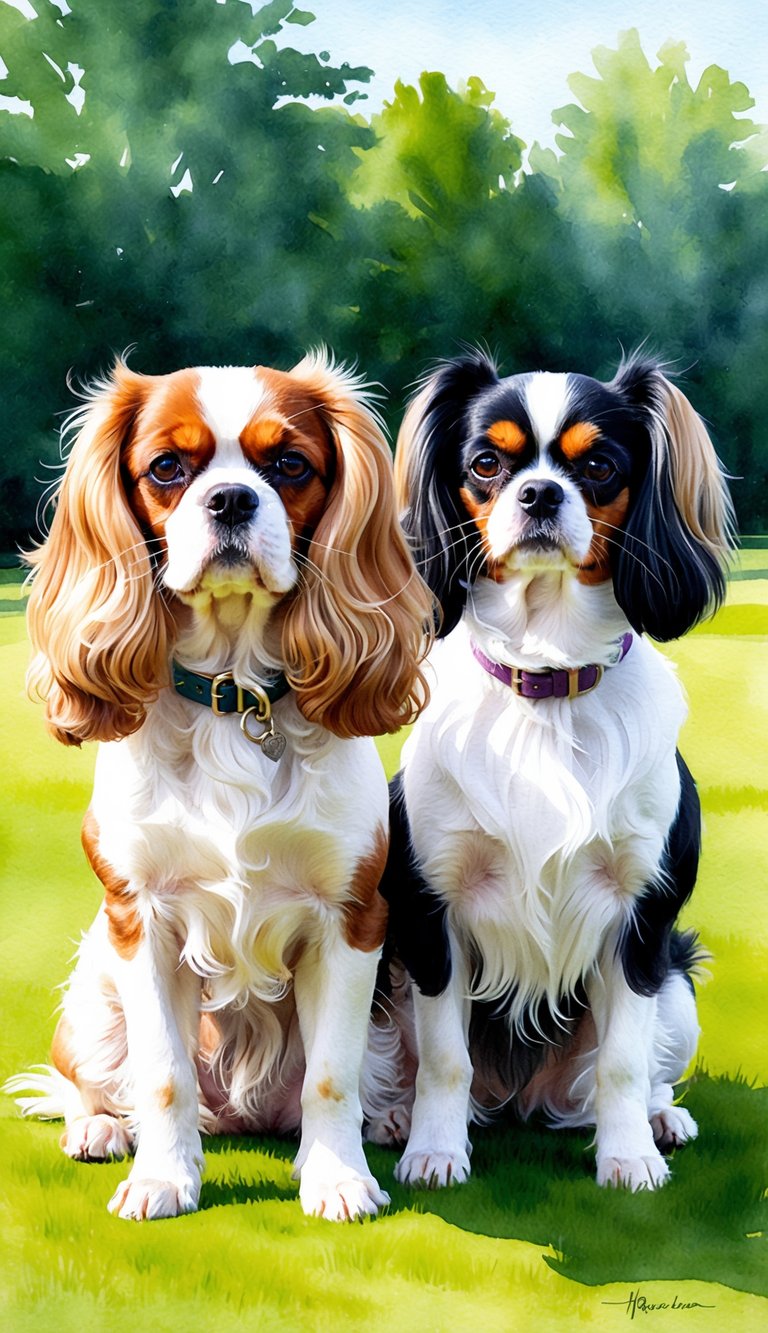
Toy breeds often seem alike, but their personalities, grooming needs, and sizes can be surprisingly different. Knowing the key differences helps you pick a breed that fits your life.
Cavalier King Charles Spaniel vs Bichon Frise
The Cavalier King Charles Spaniel is super affectionate and gentle. They’re easy-going with kids and other pets.
Their coat needs brushing a few times a week but isn’t as curly as the Bichon Frise’s. The Bichon Frise sports a soft, curly coat that needs regular brushing and professional trims.
Bichons are playful and energetic, maybe a touch more independent than Cavaliers. Both breeds are similar in size, usually 12–18 pounds.
Key differences:
- Coat: Curly and white for Bichon; silky and wavy for Cavalier
- Temperament: Cavaliers are more mellow, Bichons have a bit more bounce
- Grooming: Bichons need more frequent trims
Papillon vs Maltese
Papillons stand out with their butterfly-like ears and lively spirit. They’re active, alert, and love to learn tricks.
Their long, silky coat is straight and doesn’t mat easily. The Maltese is a fluffy, all-white toy with a long coat that needs daily brushing to avoid tangles.
Maltese dogs are gentle and loving, sometimes a bit calmer indoors. Papillons usually act more outgoing and confident in new situations.
Both breeds are small—5 to 9 pounds—and work well in apartments.
Differences at a glance:
- Appearance: Papillon’s big ears vs. Maltese’s long, draping coat
- Energy: Papillons have more pep, Maltese are quieter
- Shedding: Both shed little, but Maltese need more grooming
Differences With Other Popular Small Breeds
A lot of small breeds bring their own quirks to the table. Shih Tzu, Yorkshire Terrier, and Havanese need plenty of grooming but tend to make affectionate, adaptable family pets.
Pomeranian and Chihuahua are even tinier, often louder, and honestly, you need to handle them with extra care just because of how delicate they are.
The Toy Poodle stands out for its smarts, allergy-friendly coat, and love of puzzles or games.
Pug and French Bulldog might look tough, and they’re sweet, but they usually have less energy than, say, a Cavalier or a Papillon.
Some breeds, like the Miniature Schnauzer, lean into those classic terrier instincts and stay alert to everything around them.
You won’t really find breeds like the Beagle, Labrador Retriever, Golden Retriever, German Shepherd, or Shetland Sheepdog lumped in with these toy breeds. They’re just bigger, and their energy needs are on a different level.
For a quick look at how these breeds stack up:
| Breed | Size | Shedding | Energy Level | Grooming Needs |
|---|---|---|---|---|
| Shih Tzu | 9-16 lbs | Low | Moderate | High |
| Yorkshire Terrier | 4-7 lbs | Low | High | High |
| Pug | 14-18 lbs | Moderate | Low to Moderate | Low |
| Maltese | 4-7 lbs | Low | Moderate | High |
| Pomeranian | 3-7 lbs | Moderate | High | Moderate |
| French Bulldog | 16-28 lbs | Low | Low to Moderate | Low |


